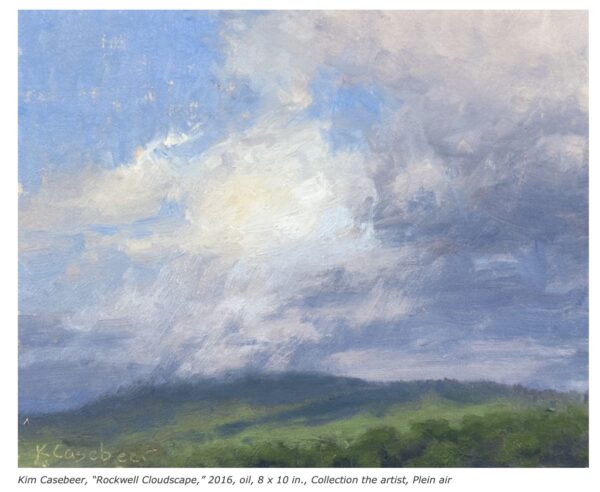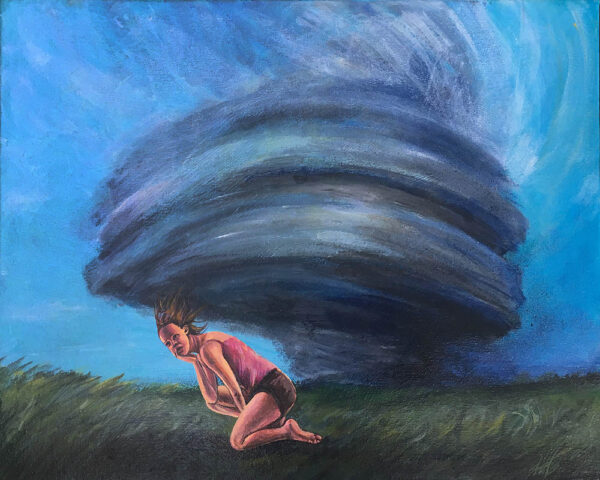Why do artists paint clouds? Because they love them, and often artists love weather in general. Weather can be very dramatic and can make an excellent artistic subject.

I just watched the movie Twisters and could totally relate to all the storm chasers in the movie. The storm chaser Kate at the center of the story just loved clouds and loved weather. I’m the same and I would have loved to have been a storm chaser or meteorologist if I wasn’t an artist. Being from central Minnesota originally, and seeing my first tornado at age 6, I have always been obsessed with clouds and weather. Many people don’t realize this but now and even decades ago, Minnesota was the upper part of “tornado alley” in the US. So I have seen my share of them, and been through plenty of nervous moments in the basement as the storm sirens blare.
When not experiencing tornados, people in Minnesota experience a lot of thunderstorms, some of them very dramatic and powerful. I have a healthy respect for storms, and love watching them develop and turn into dramatic weather, as long as I’m not in the bullseye for the damaging effects of that weather.
Clouds and weather are super dynamic and interesting and sometimes just plain beautiful so it’s no mystery to me why artists are enamored with trying to capture them.
So due to all of the above, I have drawn and later painted clouds and weather much of my life. Like this painting Sunset Woman, and Tornado Head Man, and then a painting of a woman terrified of a tornado called Expect the Unexpected.

(Sunset Woman is also available for sale. All paintings are available as prints. Contact me if they are not in the Prints gallery.)
I came across this article on Artsy today on why artists paint clouds today and the answer seems obvious to me, but maybe it will help the rest of the world understand this interest in clouds some artists have.
The sky’s far-away mystery has captivated humanity’s imagination for millenia. Ancient Greeks, for instance, believed the sky was a dome consisting of the god Ouranos’s body, held up by the titan Atlas. No matter the state of life on earth, the sky looms high above us, steadfast yet ever-changing. Artists across eras have worked with this omnipresent visual element, from the Romantic painters to contemporary talents like James Turrell and Anish Kapoor.
. . . While airplane travel has diminished some of the sky’s unattainability over the past century, it seems no amount of rocket fuel can dissolve the sky’s portentous allure. Many contemporary artists are elaborating on the time-honored transcendental approach, beyond the scope of Karma’s show. For example, Montreal-based artist Joani Tremblay creates playful depictions of the sky in her charged, framed landscapes, partly imagined and partly based on reference images. Her latest paintings focus on mountainous horizon lines, but some, like Untitled (Rain) (2023), depict clouds alone. “Sky means vastness and vastness means room for questions,” Tremblay wrote over email, adding, “Like real life, the skies are usually the source of light in the paintings, the source of luminosity.”
But for artists, transcendentalism doesn’t necessarily mean spirituality: The rhythmic qualities and color palette of a painting can create material impacts on the brain, according to the rising field of neuroaesthetics.”
. . . While humanity no longer considers the sky a vast unknowable god, it still holds a deep allure for many artists. Indeed, science is catching up to art—every new discovery raises only more questions. The sky might draw closer to artists, becoming more fathomable over time, but their experimentations will always grow deeper.”
And some artists, like me, just like painting the sky. I used to paint the sky in watercolor a lot when I was younger. Here is a watercolor of mine called Red Storm Lake from that era. (It’s still available and so are prints on demand.)





